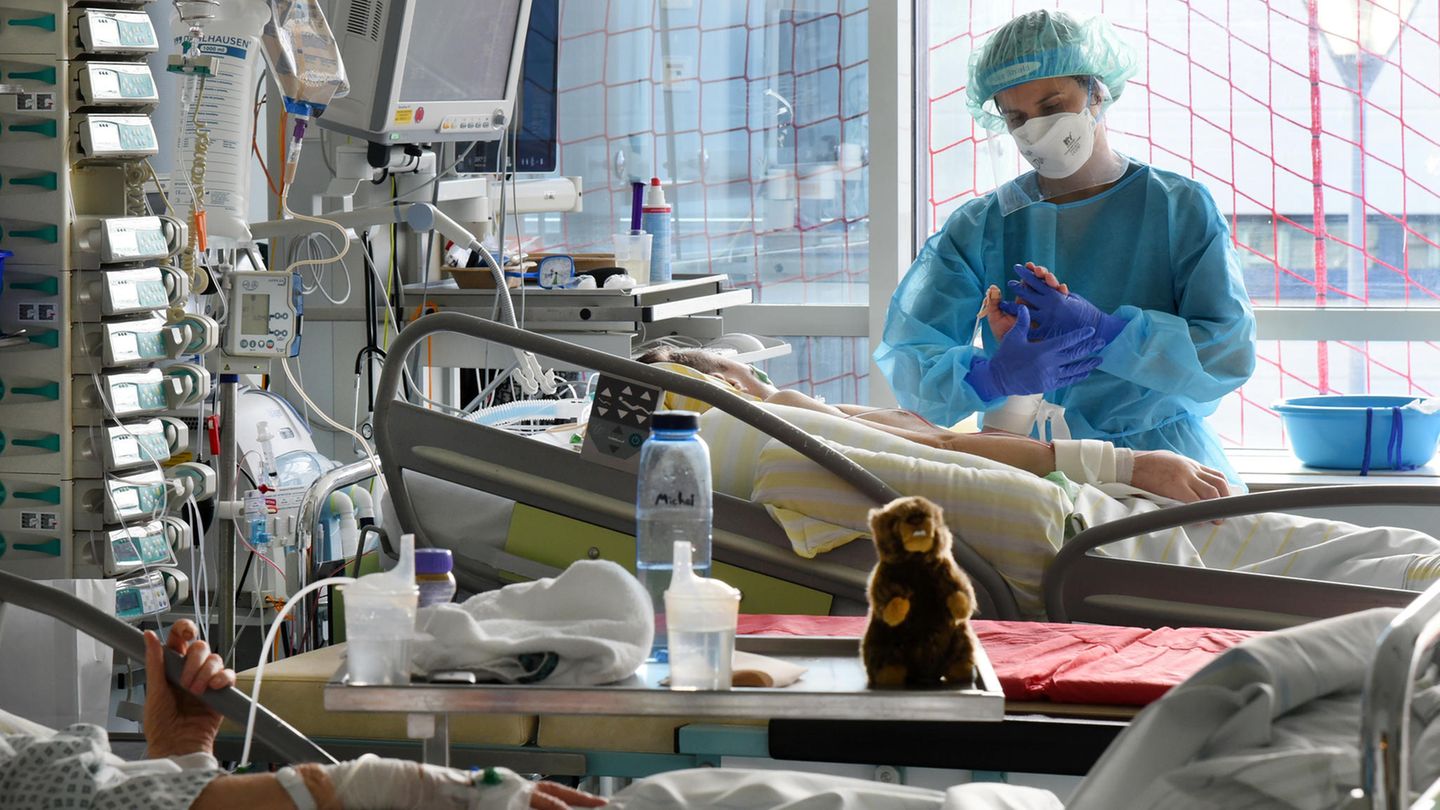Almost 90 percent of the intensive care beds are already occupied – and the corona incidence continues to rise. How much longer can the clinics hold out?
Germany hits the fourth corona wave with force. The number of detected new infections is literally exploding, more and more people need intensive medical treatment. The concern is that clinics will soon reach their limits – or are already at the limit. How much longer will it go on?
“We drive in the fog without GPS,” warns Christian Karagiannidis, head of the intensive care register of the German Interdisciplinary Association for Intensive and Emergency Medicine (Divi). Together with the mathematician Andreas Schuppert from RWTH Aachen University, he calculated how dramatic the utilization of intensive care units is: With corona incidences of 250 to 400, the nationwide occupancy increases to at least 3500 to a maximum of 6000 Covid patients. That would be a new high.
8 out of 1,000 infected people have to go to the intensive care unit
“It will be a very stormy autumn,” says Uwe Janssens, member of the Divi executive committee. According to the doctor, 0.8 percent of those infected required intensive medical treatment. One only has to keep the increasing numbers of infections in mind for the development. Of 1000 people infected with corona, eight end up in the intensive care unit.
With over 50,000 corona cases transmitted within 24 hours, the new corona infections did not reach a peak until Thursday (Friday: 48,640). From a purely mathematical point of view, around 400 of these cases end up in the intensive care unit. Gerald Gaß, Chairman of the German Hospital Association (DKG), is therefore expecting a total of 4,000 corona patients in the intensive care units by the end of the coming week.
What is it like there right now? were last treated in intensive care. “Intensive bookings across Germany are still lower than in December 2020,” compares mathematician Schuppert. At that time there were now more than 5500 patients. Over the course of the week, however, the number of new admissions per day was well over 200.
According to the DKG, an average Covid intensive care patient is “currently unvaccinated, male and middle-aged”. Because the average age of Covid intensive care patients has now fallen to below 50 years, doctors have to fight for the lives of the sick longer than before. On average, younger people spend longer in intensive care because they have a better chance of survival.
“A younger patient who has to be ventilated spends much longer in the intensive care unit,” explains Janssens. The long length of stay means an additional burden. At the previous high value in January 2021 with more than 5700 occupied intensive care beds, the patients were on average almost 80 years old, according to the DKG.
“Also a breakthrough infection pandemic”
In addition to the so-called vaccination gaps – the millions of people who are still without vaccination protection – the diminishing effect of the vaccination is also a problem. This means: people who have been vaccinated can also become infected with the virus, which becomes more likely the longer it has been since the vaccination. It is true that in this case they are significantly less likely to become seriously ill than those who have not been vaccinated. Overall, however, this is also noticeable in the clinics. Currently, 36 percent of the over 60-year-old Covid cases in intensive care units are “likely vaccine breakthroughs”,
Intensive care physician Janssens therefore predicts: “We will also have a pandemic of breakthrough infections.” According to the DKG, more than 90 percent of Covid intensive care patients were unvaccinated in September 2021, compared to 74 percent at the beginning of November.

In addition, according to the intensive care register, around 5,000 beds – including around 3,000 ventilation beds – were lost within one year. Janssens explains: “These beds are still there, but cannot be used due to a lack of staff.” That means: The shortage of nurses will make things even more difficult this Corona autumn.
How can this development be stopped so that a new high in bed occupancy is not reached? Karagiannidis speaks of a “voluntary change in behavior of the population” and names the keywords 2G, i.e. access to events only for vaccinated and convalescent people, and boosters, i.e. refreshing the vaccination status, especially for vulnerable groups. Schuppert also points out that the rate of fully vaccinated people is ten percentage points too low – it is currently 67.4 percent (as of November 12). Filling this gap would bring Germany a good deal closer to what is known as herd immunity.
Hospital traffic light on red in Bavaria
There are differences in the federal states when it comes to the situation in the intensive care units: In Bavaria, the hospital traffic light of the Bavarian Ministry of Health has jumped to red, the limit of 600 corona patients in the intensive care units has been exceeded. In addition to Bavaria, the neighboring states of Thuringia and Saxony have the highest proportions of Covid patients in the total number of intensive care beds nationwide. There – in relation to adults – more than every fifth operable bed is occupied by Covid 19 patients, as can be seen from the Divi data.
When the pressure increases, the clinics have to react. “In some regions there are already transfers to more distant hospitals,” says DKG chairman Gaß. Planned interventions are being canceled in Berlin. The number of occupied intensive care beds in Germany currently only knows one direction: upwards.
The incidence is rising, the intensive care units are filling up. “The total utilization is already almost 90 percent,” warns Gaß and adds: “That is a very high value that is normally only reached at the height of the flu and accident seasons in winter.”
Source From: Stern




